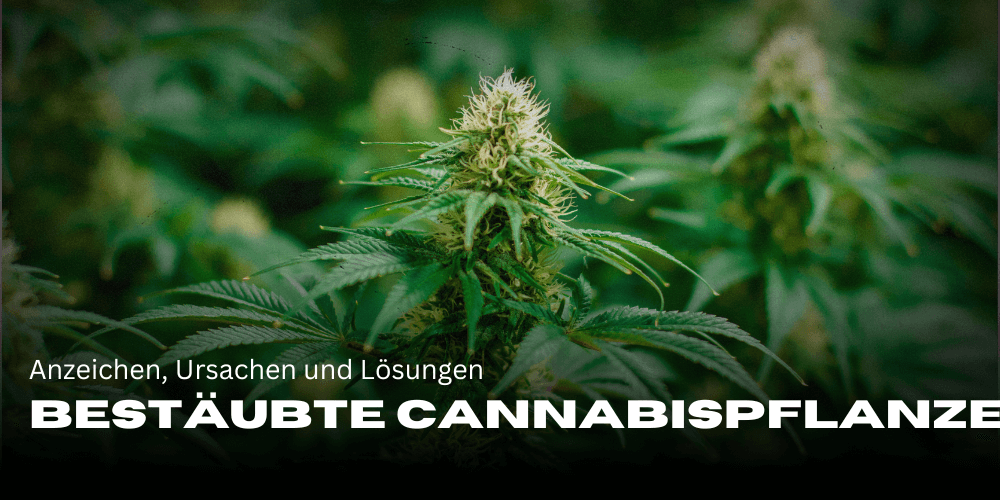Recognising a pollinated cannabis plant - signs, causes and solutions

Inhaltsverzeichnis: Recognising a pollinated cannabis plant - signs, causes and solutions
Viele Grower do everything they can to harvest dense, resinous Flowers without seeds. But sometimes things turn out differently - the plant is pollinated and suddenly it no longer puts its energy into resin production, but into seed formation. This lowers the THC content and makes the Flowers less valuable.
But how can you recognise pollination? What are the causes and how can it be avoided? That's exactly what this article is about. We explain the most important signs, show what you can do in an emergency and give tips on how to prevent future pollination. If you keep a close eye on your plants, you can look forward to a strong and flavourful harvest in the end.
How to recognise a pollinated cannabis plant
A dusted Cannabispflanze shows clear changes, which are particularly noticeable on the Flowers. The most obvious indication is seed formation. Instead of sticky, resinous Flowers, the plant develops firm, compact Flowers in which small, hard seeds grow. If you press a bud between your fingers, it often feels harder than usual.
Another sign is the decline in resin production. As the plant puts its energy into seed formation, the Flowers less sticky and shiny. This also reduces the typical, intense cannabis odour, as fewer terpenes are produced. In addition, the flower hairs (pistils) often turn brown early, even if the plant is not yet ready for harvest.
If you are unsure, you can carefully open a Flower. If it contains small, light to dark brown seeds with a hard shell, pollination is confirmed. As soon as a plant has been pollinated, it puts all its energy into seed formation - this significantly reduces the THC content and makes the Flowers less attractive for consumption.

Differences between pollinated and non-pollinated cannabis plants
The difference between a pollinated and an unpollinated cannabis plant can be seen above all in the quality of the Flowers. While unpollinated plants produce dense, resinous and strongly scented Flowers, pollinated plants concentrate on seed formation. This not only leads to less resin, but also to an altered structure of the Flower.
Pollinated plants often have harder, more compact Flowers, which when crushed produce small, solid Samen contained. In contrast, unpollinated Flowers are softer, stickier and free of seeds. The odour is also more intense in unpollinated plants, as more terpenes are produced. Another clear characteristic is the discolouration of the flower hairs (pistils). While these only turn brown in the final phase of an unpollinated plant, this often happens much earlier in pollinated plants.
The following table summarises the most important differences:
| Merkmal | Pollinated plant | Unpollinated plant |
|---|---|---|
| Blütenstruktur | Firm, compact Flowers with seeds | Dense, fluffy Flowers without seeds |
| Harzproduktion | Low, Flowers are less sticky | High, Flowers are very sticky |
| Geruch | Weaker, less terpenes | Intense, strong terpene production |
| Blütenhaare | Turn brown early | Remain white for a long time, turn brown late |
| THC-Gehalt | Lower, as energy flows into seed formation | Higher, as focus on resin production |
These differences are important for recognising pollinated plants at an early stage and taking action if necessary.
Causes of a pollinated cannabis plant
Pollination often occurs through male cannabis plants, hermaphrodite plants or foreign pollen from the environment. Male plants do not form Flowers, but pollen sacs that release fine, yellow pollen. If this is transferred to female plants, seed formation begins - male plants should therefore be removed early.
Hermaphrodite plants can also lead to pollination, as they develop both female and male Flowers. This often happens through Stress for example through light leaks, temperature fluctuations or mechanical damage. Hermaphrodites can pollinate themselves and other plants and should therefore be sorted out immediately.
Even if there are only female plants in the garden, pollen can come from outside. Wind can transport cannabis pollen over several kilometres, and insects can also spread it. It is therefore important to check outdoor grows for possible sources of pollen in the neighbourhood.
What to do if your cannabis plant has been pollinated?
Once a cannabis plant has been pollinated, this cannot be reversed - seed formation is in full swing and the THC content remains low. Nevertheless, you don't have to throw the plant away, because there are some useful ways to reuse it:
- Harvest and use seeds: If pollination has been controlled, you can use the seeds for future cultivation. However, if pollination is unknown, there is a risk of undesirable characteristics.
- Flowers further utilise: Even though they contain less THC, pollinated Flowers can be used for extracts, edibles or tinctures. They are less suitable for smoking or vaporising.
- Find the cause of pollination: Check whether a male or hermaphrodite plant in your grow was the trigger. If so, you can prevent future pollination by carrying out regular checks.
- Protect outdoor grows: If pollination was caused by foreign pollen, hedges, pollen protection nets or a roofed cultivation method can help to better protect your plants.
The earlier you recognise pollinated plants, the better you can react and protect future harvests.
Fazit
A pollinated cannabis plant may not be ideal for consumption, but it does not have to be grown in vain. If you recognise the signs early, you can react quickly and protect future harvests. Male and hermaphrodite plants should be removed as early as possible to avoid unwanted pollination. If it does happen, the seeds can be used for future cultivation or the Flowers can be processed into edibles and extracts.
The best strategy is always prevention - regular plant monitoring, good cultivation planning and protection from foreign pollen help to harvest high-quality, resinous Flowers without seeds. If you remain vigilant, you can look forward to a strong and flavourful harvest in the end.















